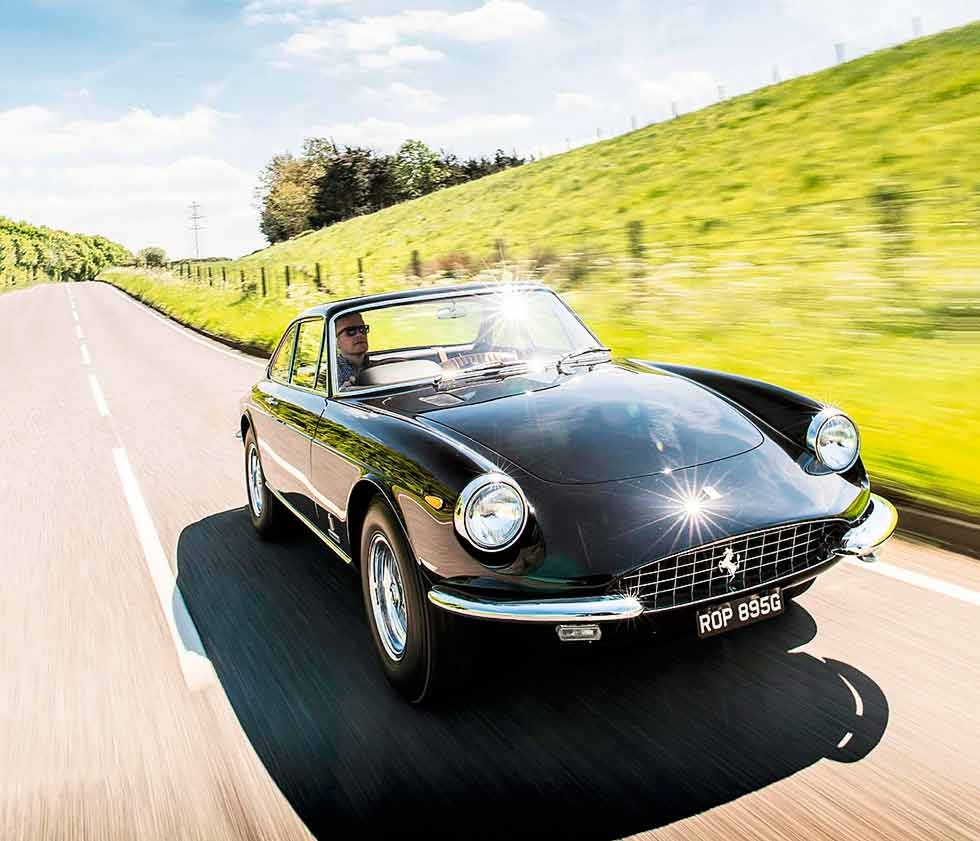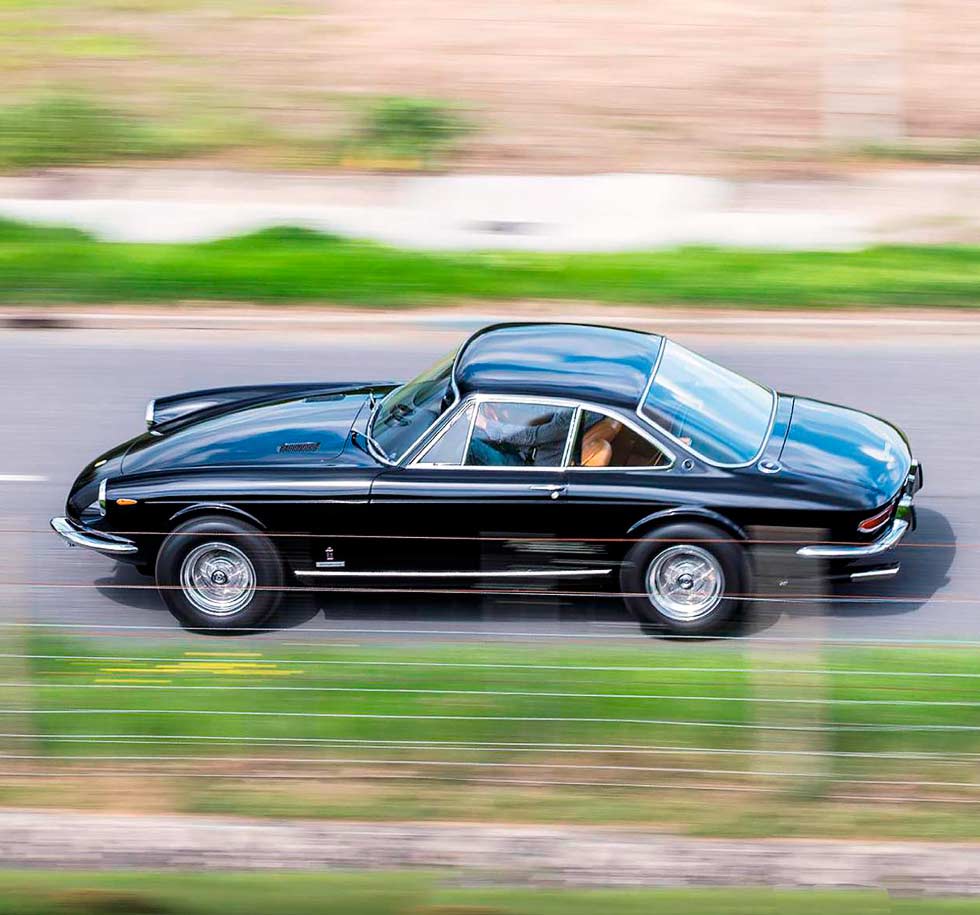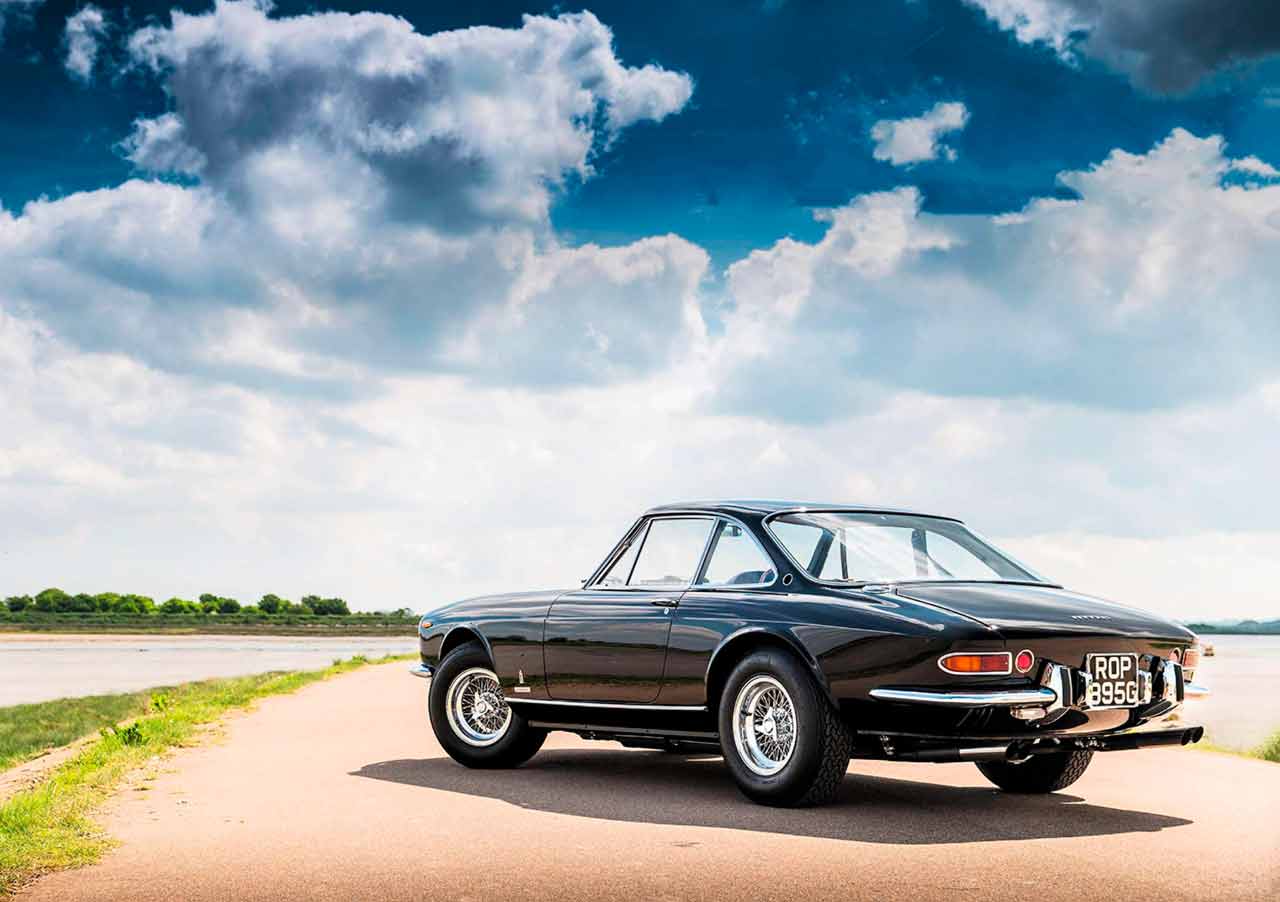
Rare 1969 Ferrari 365GTC driven. Equipped with the most potent Colombo V12 available during the golden era of grand touring, the Ferrari 365GTC could flow across continents yet envigorate through curves. Today, we drive a rare right-hand-drive example in the UK. Words Richard Heseltine. Photography Adam Shorrock.
12-Shot Expresso We shine a light on that most unusual of creatures – an underrated yet rare car from Maranello. In this case the Ferrari 365GTC
Chasing the good life in a rare Ferrari 365GTC
As backdrops go, a trading estate in Essex doesn’t quite lend the appropriate Jet-Set vibe, but that’s of little consequence right now. I have a vivid imagination. I’m idly daydreaming of crushing continents in a single bound; of being an international playboy accompanied by an international playgirl en route to the latest hot spot of the beautiful people. This delicious Ferrari 365GTC has that effect. It screams late-Sixties soft-focus glamour. My blissed-out reverie is only heightened on starting the V12. Switch on the ignition, listen for the faint sound of the high-pressure fuel pump, give the throttle a few pumps and then turn the key. What follows is the rustle of chains, hum of intakes and the most choral of backbeats.

Idling at less than 1000rpm, it’s a bit lumpy, which gives me an excuse to blip the throttle; just to clear the plugs you understand. As is typical of this era of Ferrari, the GTC has a dogleg first. Press in the unyielding, single-plate clutch, ease into gear and engine response is immediate. Shift into second with a slight ker-klunk against the spring bias – the transmission oil isn’t warm yet and it’s a transaxle so there are long linkages – and it’s easy to feel intimidated by the baulking of metal connecting with metal.
Having negotiated roadworks and stop-start traffic, and once into open countryside, this sinister black projectile comes alive. More speed, more revs and shifting from second to third needs to be done vigorously because it doesn’t respond to tactility. Ferrari used Porsche synchronisers and there’s some resistance across the gate, as is to be expected. Third to fourth is lightning quick, but the mass of the driveshaft at engine speeds has to synchronise as well as the gears so the procedure may seem a little hit and miss until you’ve become accustomed to it. Into top for cruising and only tyre roar and buffeting from the A-pillars detract. Acceleration in any gear is immediate – there’s no hesitation as it waits to get on its cams. Let it stray into the upper reaches and the rumble becomes a bellow becomes a scream. When cruising, it’s certainly audible but never intrusive.
There is so much to love here. The expectation that it will be slow-witted evaporates at even moderately enthusiastic speeds. Aboard, say, a 250GTE, or even a Lusso, a certain degree of physicality is demanded for fast progress cross-country. That isn’t the case here. For a large GT, you’re aware of sitting near the rear wheels because of the short wheelbase but the tail doesn’t threaten to spill. Unlike the earlier GTs that were set up to understeer, the shorter-wheelbase 365GTC feels neutral.

That said, the controls are initially weighty, just to remind you that this a Sixties Ferrari. The unassisted steering starts off leaden, but such early effort is forgotten once you’re up to speed. The sense of weight dissipates and the 365GTC steers neutrally, if not altogether quickly, with negligible kickback. It doesn’t feel particularly skittish over undulating surfaces, either. In period, the Girling disc brake set up came in for criticism but it’s hard to see why. The pedal is assisted by two huge servos, with divided circuits and a tandem master cylinder, and feels over-sensitive at slow pace, but the bite is reassuringly accurate and easy to modulate at higher speeds. This is the sort of car that you can have fun playing with, and it is markedly more user-friendly than most comparable Astons and Maseratis. And while not quite in the same league as a 365GTB/4 Daytona for sheer accelerative force, it isn’t far behind – plus it’s more user-friendly in the real world, and with appreciably better ride quality. It’s equally as at home negotiating sleeping policemen in sleepy villages in the south-east of England as it is, I imagine, cresting the undulations of the Autostrada at licence- losing speeds.
It’s compelling, that’s for sure. So much so, you have to wonder why its praises aren’t sung more loudly. That said, in order to understand the model’s place in Ferrari lore, first you need to appreciate the car that bore it – the 330GTC. Introduced at the March 1966 Geneva Motor Show, and slotted in the line-up between the 275GTB and the 330GT 2+2, the new subspecies borrowed its short-wheelbase (2400mm) frame and independent rear end from the former.
This was an excellent choice, the GTB proving itself in competition by taking class honours at Le Mans just a few months later. It was the only Ferrari to finish the endurance classic that year.
Just as night follows day, the 330GTC’s silhouette was the work of long-time collaborator, Pininfarina. There was nothing particularly daring about the outline; no pushing envelopes or breaking moulds here. Instead, there was a degree of familiarity with other models, the front end being pure 500 Superfast, the rear end having been lifted wholesale from the 275GTS (see also the Turin styling house’s one-off Rondine Corvette show queen). Only the centre section was anything like original but, if you’re going to ransack a back catalogue, Pininfarina’s is as good a place to start as any. As to who precisely was responsible for shaping the car, it depends on whose version of history you believe because designers were rarely acknowledged in period – there’s no T in team and all that. Decades down the line, credit has retrospectively been bestowed on former Cisitalia man Aldo Brovarone, this likable artiste having also penned the 400 Superamerica Coupe Aerodinamico and the Dino Berlinetta Speciale that foretold the 206GT production car.
Beneath the skin it was similarly a mixture of something borrowed, something new. Period factory literature claimed a useful 300bhp from the enduring V12. Considering manufacturers’ penchant for, cough, ‘fine-tuning’ power output figures in period (or just randomly plucking a number out of the air), this is perhaps a little fanciful and definitely a net figure. Even so, the Tipo 209/66 unit was a gem. With a displacement of 3967cc, the cylinder block, heads and crankcase were cast in alloy but with iron liners in the block and a seven-main bearing crankshaft honed from solid steel billet; this was a hugely exacting and labour-intensive method of construction. It was chain-driven – naturally – with single overhead camshafts per bank, and carburation was by three twin- choke Webers straddling the 60-degree vee.
As with most Ferraris of the period, the 330GTC’s design blended contemporary technology with time-honoured practices. Mounted, like the engine, on rubber bushes to reduce vibration, the five-speed transmission sat in unit with the spiral bevel final drive at the rear, with engine and transaxle joined by a torque tube. It was suspended on double wishbones and coils all-round, with anti-roll bars, co-axial springs and Koni dampers, and braking was via big servo-assisted discs with twin circuits, with steering by a worm and roller set-up. The steel body was then welded and bolted to the ladder/perimeter frame combo with a tendril-like multi-tubular structure affording supplementary support.
Predictably the GTC bore an open version, the 330GTS being aimed at the Stateside market. Mechanically identical to its fixed-lid brother, the Spider was heavier at 1408kg (3105lb) and slightly slower at I46mph outright, but what’s five mph between friends? Clearly 100 punters felt similarly, Ferrari scoring a century to 1968 along with around 600 GTCs. Not bad for a two-year production run.
Following the introduction of the 365GT 2+2 at the 1967 Paris Motor Show, it was only a matter of time before the model’s latest Tipo 592 strain of this enduring V12 found its way under the bonnet of the 330GTC, and thus the 365GTC was born midway through 1968. While the stroke remained the same as with the outgoing model at 71mm, the bore size was increased 4mm to 8lmm for a displacement of 4390cc. This hike in capacity, plus the adoption of a triple Weber 40 DFI/5 arrangement, boosted horsepower by 20bhp. This might not seem like much of a difference, but the torque spread was that much wider.
The only stylistic change of note over the preceding 330GTC concerned the removal of air inlets from front wings, with smaller vents being sunk into the bonnet in their place. But then why would Ferrari have wanted to change a single line? Though not feted as one of Pininfarina’s landmark creations, it really should be. The 365GTC – like its forerunner, is commendably free of stylistic tinsel. The real power here is that of restraint. The car’s long, imperious nose, gaping maw and tusk-like quarter bumpers lend it presence, the high waistline tapering into the understated rear, all topped by an expansive glasshouse with spindly pillars for panoramic all-round visibility. Resplendent in deepest nero, and riding on Borrani wire wheels with three-ear spinners, it really is magnificent.
It is surprisingly dainty, too. Photos do not lend a sense of scale. The 365GTC is just 1626mm wide, which makes it three inches narrower than a hardly elephantine Dino 206GT. It is also 4505mm long and stands just 1314mm off the deck so it doesn’t take up a lot of acreage. Nevertheless, real thought went into the packaging. This is a proper gran turismo with all that entails.
For starters, there’s no need to stoop and tumble into the driver’s seat, unlike with so many contemporaries. It’s an inviting cabin, too. The instrument layout is coherent, with large white-on- black Veglia speedo and rev counter mounted directly in front of the driver within an ovoid binnacle, oil pressure and temperature gauges sited between them. Other dials in the centre of the dash’, however, appear a little lost and aren’t altogether easy to read at a glance, while the bank of toggle switches on the centre console are baffling without familiarity. The Nardi wheel is at the expected bus-like angle, prompting the usual arms straight, knees slightly splayed driving stance.
You barely notice this after a while.
Autocar, a publication that half-a-century ago rarely indulged in hooliganism, made an exception for the 365GTC. The cover image depicted one amid a fug of charred rubber, its rear tyres ablaze as it blasted off the
line. Maranello’s finest was famously loath to let anyone perform outside evaluations of its wares, and the motoring weekly was obliged to borrow one from Rob Walker’s Corsley garage before testing it at the MIRA proving ground. It reported breathlessly, ‘From a standing start, the acceleration is breathtaking, 100mph being reached in a fearsome 14.7sec through the gears, and 120mph in only 21.8sec. On the MIRA horizontal straight, we reached 120mph in under one mile from rest – something we have never achieved there before, with 127mph coming up at the end of one kilometre.’
It went on to add, As far as the fundamentals go, and the 365GTC is tremendously dynamic in each department, the Ferrari lived up to every expectation and even exceeded our wildest hopes. For the price of a substantial house, and with a fuel consumption which fills a Green Shield stamp book every 800 miles, this car is only for the affluent. But even by their standards, it never fails to impress the driver, passengers, bystanders, executive chairmen and, above all, cognoscente and enthusiasts.’
Nothing has changed in the interim. Just 168 365GTCS were built to 1970 along with 20 open variants. A mere 22 right-hand-drive fixed-head coupes were made, making this among the rarest production models ever to emerge from Maranello. It is also one of the most enjoyable to drive, if not the best-remembered. In this respect, it’s that rarest of things – an underrated Ferrari. It may not be the best Sixties GT, but it’s hard to think of one that is more civilised or playful when you want it to be. The passing of half a century hasn’t diminished its spell, that’s for sure.
Thanks to hoylefoxclassics.co.uk
Tech and photos
TECHNICAL DATA FILE SPECIFICATIONS 1969 Ferrari 365GTC
Engine 4390cc, 60deg V12, triple twin-choke Weber 40 DFI/5 carburettors, seven-bearing crank
Max Power at 320bhp @ 6600rpm / DIN nett
Max Torque at 268lb ft @ 5000rpm / DIN nett
Transmission five-speed manual, rear-wheel drive
Steering ZF worm and roller
Suspension Front: independent by coil springs, double wishbones, Koni telescopic dampers. Rear: independent by coil springs, double wishbones, telescopic dampers
Brakes Girling dual-circuit discs front and rear with Bonaldi servo assistance
Weight 1450kg (3198lb)
Performance
Top speed: 151mph
0-62mph: 6.3sec
Fuel consumption 12mpg
Cost new £7909 (in 1969 UK)
Classic Cars Price Guide (in 2018-2019 UK) £450,000-690,000

“The expectation at it will be slow-witted evaporates at even moderately enthusiastic speeds”


THE SPECIALIST’S VIEW
Simon Raw of marque specialist Hoyle Fox Classics is well-versed in classic front-engined V12 Ferraris, the 365GTC being among his favourites, but then he did revive the example tested here.
Says Raw, ‘With the restoration of any Sixties Ferrari, the hardest aspect is making a car as good as it should have been when it left the factory. By that, I should say probably better than in period while preserving as many original parts as possible; retaining the original running gear, carburettors, distributors, and so on. We also have to ensure that the car will comply with Ferrari’s Classiche certification programme so any incorrect parts fitted over the years need to be removed and replaced with original items.
‘Right-hand-drive cars command a premium because of their rarity. Running costs are not necessarily horrendous but they quickly escalate if a car requires major rebuild/restoration work. Annual servicing costs would probably be somewhere in the £600-1000 range. A full engine rebuild would be anywhere from £20,000 upwards depending on the condition of the engine to begin with. Transmission rebuilds would likely be £5000 upwards, but again that’s dependent on condition.’
‘The 365GTC has many similarities to the 330GTC; superior brakes to the 275GTB, an improved powertrain over early 275s for that matter, but with a similar suspension arrangement and transmission. The 365 is also noticeably torquier than the 275 or 330 models.’






